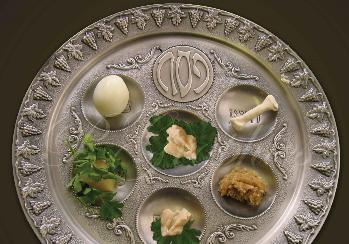 The word ‘Seder’ means ‘order’ or ‘method’. During the Seder, we follow specific rituals. Now for the exciting part that you may be more familiar with.
The word ‘Seder’ means ‘order’ or ‘method’. During the Seder, we follow specific rituals. Now for the exciting part that you may be more familiar with.
The first night of Passover is when the Jewish people actually brought the Passover sacrifice and ate it before G-d at midnight smote (“killed”). G-d killed all of the firstborn sons of Egypt at midnight.
The Korban Pessach (Passover sacrifice was eaten before the killing of the first-born) the same night. The Jews left Egypt the next day at Noon. (believe it or not). So the first night (and outside of Israel, the second night as well), we celebrate by having a Seder. Three special matzos (representing the Konen, the Levite, and the Yisroel) each wrapped separately and placed one on top of the other on a plate on the Seder table. These matzos are specially prepared for use during Pessach containing only flour and water. Also called ‘bread of affliction’, this unleavened bread reminds us of what our people ate in the land of Egypt. They were in a hurry to leave that they had no time to let the dough rise.
Each person at the Seder drinks four ‘kosos’ of wine. The number four signifies the four expressions of Redemption which G-d used when sending Moses to free us (Exodus 6.6-7). The wine symbolizes joy and happiness.
On the Seder Plate:
 1. ‘Zeroa’ which is usually a boiled or a broiled neck of chicken. This is a symbol for the Paschal Lamb that is offered on the 14th day of Nisan during the time of the Bais Hamikdosh (Holy Temple in Jerusalem), Neither the Zeroa nor any broiled meat may be eaten on the Seder nights. It is only placed on the plate.
1. ‘Zeroa’ which is usually a boiled or a broiled neck of chicken. This is a symbol for the Paschal Lamb that is offered on the 14th day of Nisan during the time of the Bais Hamikdosh (Holy Temple in Jerusalem), Neither the Zeroa nor any broiled meat may be eaten on the Seder nights. It is only placed on the plate.
 2. ‘Baytza’, a hard boiled egg that is partially broiled after cooking. It symbolizes the ‘Chagigah’ (festival offering) that is offered during the three major festivals when we had the Bais Hamikdosh.
2. ‘Baytza’, a hard boiled egg that is partially broiled after cooking. It symbolizes the ‘Chagigah’ (festival offering) that is offered during the three major festivals when we had the Bais Hamikdosh.
 3. ‘Moror’, usually Romaine lettuce or grated dry horseradish. These bitter herbs reminds of the time when our people were under Egyptian yoke and their lives were embittered by hard labor at clay bricks and all manner of toil in the fields.
3. ‘Moror’, usually Romaine lettuce or grated dry horseradish. These bitter herbs reminds of the time when our people were under Egyptian yoke and their lives were embittered by hard labor at clay bricks and all manner of toil in the fields.
 4. `Charoses’ – a mixture usually composed of nuts, grated apples, (cinnamon and ginger) with a bit of wine added to make it a paste. During the Seder the moror is dipped into the Charoses. This, too, is a symbol of slavery. It resembles the mortar at which our ancestors worked during their enslavement.
4. `Charoses’ – a mixture usually composed of nuts, grated apples, (cinnamon and ginger) with a bit of wine added to make it a paste. During the Seder the moror is dipped into the Charoses. This, too, is a symbol of slavery. It resembles the mortar at which our ancestors worked during their enslavement.
 5. ‘Karpas’ – a vegetable such as boiled potato, onion, radish, etc. The vegetable is dipped into salt water. The reason for this and eating it so much prior to the actual meal is to arouse the curiosity of the children to inquire as to the meaning of this irregularity. The father will then have an opportunity to explain the significance of this night and details of the exodus of Egypt.
5. ‘Karpas’ – a vegetable such as boiled potato, onion, radish, etc. The vegetable is dipped into salt water. The reason for this and eating it so much prior to the actual meal is to arouse the curiosity of the children to inquire as to the meaning of this irregularity. The father will then have an opportunity to explain the significance of this night and details of the exodus of Egypt.
The reason that salt water is used with Karpas is to point to our present status as free men. The food that was served to us in Egypt was prepared without salt, which was considered a delicacy reserved for the free. Some say that the salt water also signifies the bitter tears that flowed from the Israelites as they were oppressed in Egypt.
We follow a book called the ‘Haggadah’ which contains the narration and ceremonials of the Seder for participants to follow. The Haggadah is based on the biblical commandment “And you shall narrate to your son on that day, saying: ‘It is because of that which the Lord did for me when I came forth out of Egypt’. In reading the Haggadah, we are observing the command to narrate the tale of the exodus from Egypt.
During the Seder, there is a custom where we pour wine into a special cup and call it ‘Kos Shoi Eliyahu’ – the Cup of Elijah. This custom comes from an old Talmudic controversy as to whether there should be four or five cups on Seder night. According to tradition, Eliyahu Hanavi actually comes to each Seder. To symbolize the coming of Elijah, we stand up and welcome him with the words Baruch Haba (Blessed be he who comes).




